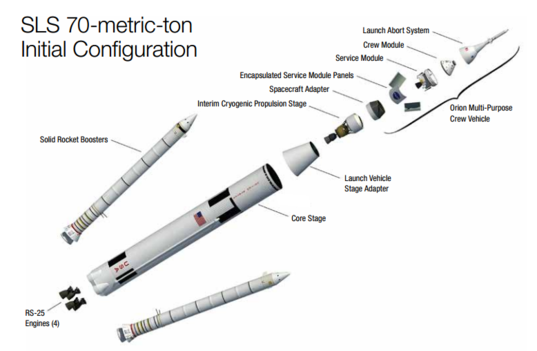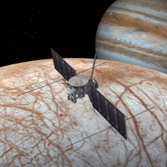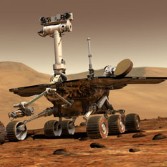NEWS | SEPTEMBER 29, 2016
Curiosity Finds Evidence of Mars Crust Contributing to Atmosphere

› Full image and caption
NASA's Curiosity rover has found evidence that chemistry in the surface material on Mars contributed dynamically to the makeup of its atmosphere over time. It's another clue that the history of the Red Planet's atmosphere is more complex and interesting than a simple legacy of loss.
The findings come from the rover's Sample Analysis at Mars, or SAM, instrument suite, which studied the gases xenon and krypton in Mars' atmosphere. The two gases can be used as tracers to help scientists investigate the evolution and erosion of the Martian atmosphere. A lot of information about xenon and krypton in Mars' atmosphere came from analyses of Martian meteorites and measurements made by the Viking mission.
"What we found is that earlier studies of xenon and krypton only told part of the story," said Pamela Conrad, lead author of the report and SAM's deputy principal investigator at NASA's Goddard Space Flight Center in Greenbelt, Maryland. "SAM is now giving us the first complete in situ benchmark against which to compare meteorite measurements."
Of particular interest to scientists are the ratios of certain isotopes - or chemical variants - of xenon and krypton. The SAM team ran a series of first-of-a-kind experiments to measure all the isotopes of xenon and krypton in the Martian atmosphere. The experiments are described in a paper published in Earth and Planetary Science Letters.
The team's method is called static mass spectrometry, and it's good for detecting gases or isotopes that are present only in trace amounts. Although static mass spectrometry isn't a new technique, its use on the surface of another planet is something only SAM has done.
Overall, the analysis agreed with earlier studies, but some isotope ratios were a bit different than expected. When working on an explanation for those subtle but important differences, the researchers realized that neutrons might have gotten transferred from one chemical element to another within the surface material on Mars. The process is called neutron capture, and it would explain why a few selected isotopes were more abundant than previously thought possible.
In particular, it looks as if some of the barium surrendered neutrons that got picked up by xenon to produce higher-than-expected levels of the isotopes xenon-124 and 126. Likewise, bromine might have surrendered some of its neutrons to produce unusual levels of krypton-80 and krypton-82.
These isotopes could have been released into the atmosphere by impacts on the surface and by gas escaping from the regolith, which is the soil and broken rocks of the surface.
"SAM's measurements provide evidence of a really interesting process in which the rock and unconsolidated material at the planet's surface have contributed to the xenon and krypton isotopic composition of the atmosphere in a dynamic way," said Conrad.
The atmospheres of Earth and Mars exhibit very different patterns of xenon and krypton isotopes, particularly for xenon-129. Mars has much more of it in the atmosphere than does Earth.
"The unique capability to measure in situ the six and nine different isotopes of krypton and xenon allows scientists to delve into the complex interactions between the Martian atmosphere and crust," said Michael Meyer, lead scientist for the Mars Exploration Program at NASA Headquarters in Washington. "Discovering these interactions through time allows us to gain a greater understanding of planetary evolution."
NASA's Mars Science Laboratory Project is using Curiosity to determine if life was possible on Mars and study major changes in Martian environmental conditions. NASA studies Mars to learn more about our own planet, and in preparation for future human missions to Mars. NASA's Jet Propulsion Laboratory, a division of the California Institute of Technology in Pasadena, manages the project for NASA's Science Mission Directorate in Washington.
For more information about SAM, visit:
SAM experiment data are archived in the Planetary Data System, online at:
For more information about Curiosity, visit:
The research paper is available at:
News Media Contact












You frame these as risks that are unique (or at least more probable) with newly designed hardware, and which can be mitigated by emphasizing the use of existing hardware. But that is not necessarily the case.
Only legitimate scientific organizations such as NASA, and only after rigorous planetary protection plans, should be allowed to send human investigators, not colonists.
SpaceX has a clear record of huge cost reductions. E.g. NASA’s Dan Rasky, discusses a study of F1/F9 dev cost vs the NASA/USAF cost model - https://youtu.be/xYpvvq0fqwE. The model said $4B but SpX spent only $400M. F9 launch costs are 2-3 lower than competitors, who must now develop new LVs. (Yes, there have been F9 failures but same for other LVs in early operations.)
The Society, Explore Mars, etc. will strain their credibility to the breaking point if they continue to put out “affordable” Mars plans that ignore SpX (and Blue Origin, etc) and the huge gains in costs and capabilities they can provide.
That would essentially equate to one MAVEN anyway, both in terms of cost and instrumentation, so what would be the point?
And even that would be assuming you would be sending those nine MOMs all at once. If instead NASA sent them one at a time then it would be taking about 20 years (assuming 26 months between missions) to obtain the same data that a single MAVEN acquired in a single mission.
Imagine if NASA took that same, low-budget, serial approach with ALL its Mars missions, landers as well as orbiters. At that rate to get to where we are today in terms of knowledge about Mars, it would take NASA until sometime NEXT century to obtain the same information about Mars that it has acquired to date.
In short, you get what you pay for.
It's much less fun to watch NASA hack away at problems of politics, policy, and funding.
But the truth is, supporters of space exploration must solve both types of problems in order to build a robust, fruitful, sustained program.
Presidents and Congresses come and go. Companies like SpaceX and Blue Origin can't pay for crewed missions on their own, at least not indefinitely, because there is no viable business model for exploration. Tourism, maybe. But one tragedy can bring that approach to a halt pretty quickly.
I am a member of the Planetary Society because its members are tackling both problems: technology and policy. The organization may be out-sized by these challenges, but tackling only one at a time seems like a mission to nowhere.
Once transport to Mars is cheap (he thinks $200k per person trip is realistic), there will be enough adventurous individuals who can raise the funds to pay for their trip. People would sell their homes. Wealthy parents could - highly reluctantly - pay for their children. Foundations and crowdfunding drives would pay for highly talented younger people to make the trip.
As soon as this dynamic starts gathering momentum, and it seems like the Mars colony is really happening, everyone else will jump on the bandwagon. Corporations will want to be there. Nation states will want to establish their own presence. The floodgates of private and government money open.
You just have to jump start this process, and it becomes self-sustaining. Musk is willing to do what it takes, including investing his private fortune which he only made for this one purpose.
I'm no expert in genetics, but it seems reasonable to me that DNA analysis is or will be sophisticated enough to distinguish between microbes that have been on